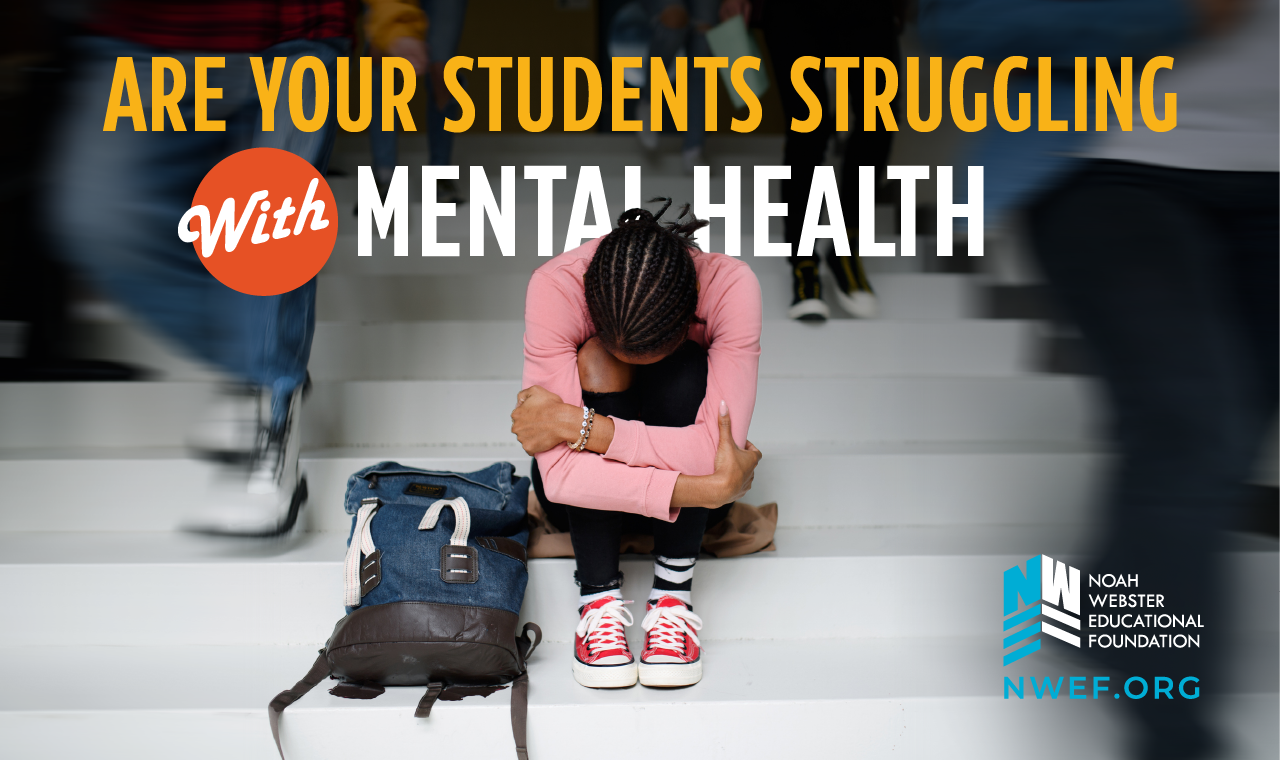
Mental health in America is at an all-time low. And adults aren’t the only ones suffering from mental disorders; many children exhibit signs of poor mental health and have also become increasingly depressed, anxious, or suicidal.
In fact, the CDC estimates that between 2016 and 2019, about 6 million children were diagnosed with ADHD, 5.8 million with anxiety, and 2.7 million with depression. Not only that, but diagnoses of “either anxiety or depression among children aged 6–17 years increased from 5.4% in 2003 to 8% in 2007 and to 8.4% in 2011–2012.” Furthermore, suicide is the third leading cause of death in ages 15-24 years old.
This increase is cause for concern for many, not the least of which are teachers. As a teacher, you spend almost entire days working with children. Many of those children are struggling mentally and emotionally. Some may have home troubles, identity challenges, or personality and behavioral issues. The mental health of one child can affect both the teacher and the other students, so it is critical that a teacher identify the problem and handle it appropriately for the wellbeing of the children.
For teachers, poor mental health in students is a challenge that is not going away anytime soon. So it’s important to know the warning signs.
9 Warning Signs That Your Student Is Struggling With Mental Health
“Mental health includes children’s mental, emotional, and behavioral well-being. It affects how children think, feel, and act,” the CDC says. “It also plays a role in how children handle stress, relate to others, and make healthy choices.” The American Foundation for Suicide Prevention says “in 2020, adolescents and young adults aged 15 to 24 had a suicide rate of 14.24,” per every 100,000 individuals.
If a child has bad mental health or a mental disorder, it can cause a change in the way they learn and behave. And, in the worst case scenario, it can be life-threatening, leading to suicide. Here are nine signs that you, as a teacher, can look for in your students to help you evaluate their mental state and help them heal.
1. Not completing school assignments
Sometimes a student will fail to complete homework or other assignments if he or she is struggling with depression or anxiety. Particularly, if in the past the student never missed an assignment, this can be a strong indicator of mental distress. Often, especially in teenagers, this can be the result of a lack of motivation, stemming from depression; some even begin to believe school is a waste of time. It could be a sign that all is not well at home. Or it may simply be a case of perfectionism and overthinking, which can lead to extreme anxiety if not addressed.
If your student regularly fails to hand in school assignments, he may even begin to show up late for school or skip school altogether. This can be an additional, and more serious sign, of depression or anxiety.
2. Isolation
Even if your student shows up for classes everyday, if he’s struggling, he may become increasingly isolated from other people. If you notice he is spending the majority of his time alone, stays mostly on the sidelines, or doesn’t show up for events, keep an eye out for other signs of a mental health disorder. Although it’s okay to be a bystander, sometimes these signs point to something bigger than just introversion.
3. Unhealthy eating habits
A critical sign that a child is dealing with a mental health issue is if he or she has an eating disorder.
The most obvious sign of an eating disorder is weight loss, weight gain, or both within a short period of time. Your student may also skip meals, throw away their food, or take frequent bathroom breaks. Take note if a student seems preoccupied with their weight or body image. Is she often distracted by food or an unhealthy amount of exercise? Has he ever been bullied about his weight in the past?
You may also want to keep an eye out for isolation, high levels of negative emotions, or a lack of emotions/numbness if you suspect your student has an eating disorder.
4. Changes in appearance or interests
You’ll notice, especially as your students become teens, that their interests and the way they dress and talk begin to change. Often these changes can be positive as your students come to understand themselves better and start to grow into young men and women. But sometimes, drastic or negative change could be indicative of an underlying mental health issue.
For instance, if a child suddenly loses interest in keeping up personal hygiene, that could indicate depression. Or maybe a teen begins to dress in a way that suggests moodiness or a disinterest in how she looks that leads to a sloppy appearance. Maybe he becomes more and more interested in morbid subjects, and has trouble maintaining a healthy sleep pattern, causing him to under-preform at school.
All of these can be an indication that the student is depressed and may eventually lead to suicidal thoughts or actions.
5. Negative responses to home life
Problems at home can be a key ingredient in children’s struggle with mental health. No matter what their age, kids can be profoundly affected by their home life, both positively and negatively.
If a child’s parents are going through a divorce, or the child has an unstable parent or guardian, that child is at more of a risk for developing mental health problems “including academic difficulties (e.g., lower grades and school dropout), disruptive behaviors (e.g., conduct and substance use problems), and depressed mood,” says the National Library of Medicine. This is especially true if she is being sexually, verbally, or emotionally abused. It’s a good idea to try to understand what your student’s family status is and look out for clues in the child’s behavior and attitude. The biggest indicator to you as a teacher may be things your students say about what’s happening at home and how they feel about it. If there are troubles at home, you can be sure that your students will be struggling, on some level, with those challenges.
6. Self-condemning comments and notes
Child and teen suicide just keeps rising year after year. U.S. News notes that “There has been a 4.5-fold increase in suicidal ingestion cases among children between the ages of 10 and 12 since 2000.” And it’s even worse for teens. “Suicide is the 3rd leading cause of death for 15 to 24 year old Americans,” according to Save.org. What can teachers do about it?
One of the best preventatives is knowing the signs. “Although many suicidal children and adolescents do not self-refer, they do show warning signs to their peers, parents or trusted school personnel. Never ignore these signs,” says the state of Nevada’s suicide prevention website.
Some of the most common signs are suicide notes and threats.
If you find a suicide note or a darkly dangerous doodle in your student’s notes that seem to indicate violence or self-harm, be sure to take the problem to someone in your school who will deal promptly with the situation. Or, if you overhear a conversation that implies the same, then take steps to make sure your student will be safe.
7. Substance use
Self-medication using drugs and alcohol is a sure sign that a student is struggling. If a teen turns to substances because of depression, anxiety, family or school problems, it can lead to much worse mental health issues down the road.
If a student is abusing substances, his grades may suddenly drop, or he might be late to school, act tired, moody, or violent. Young people can become addicted to drugs and alcohol much faster than adults, especially if they have a mental health disorder in the first place. So watch out for drug and alcohol use in your students. It could indicate a much deeper problem.
8. Bullying other children
We know that bullying can lead to mental health struggles in children. If a child has been bullied in your class, you should keep an eye out for the negative effects and try to curb them if you can.
But what about the bully? Could one of your students be a bully? What does that say about their mental health?
Some bullies actually lash out at others to compensate for their low self-esteem, depression, and anxiety. Many children who were bullied in the past become bullies themselves. Pay attention to your students’ behavior. Bullies usually exhibit what are called “gateway behaviors” such as derisive laughing, eye-rolling, stalking, or prolonged staring at their victim. Noticing and dealing with these behaviors in that student, or group of students, can stop bullying before it starts.
9. Identifying as gay or transgender
An increasing number of children and teens are identifying as transgender today. In fact, the amount has doubled in the past five years, a UCLA study found. Even more intentify as gay or bisexual.
And with this spike comes some concerning mental health stats. Medical New Today reports that transgender teens are 7.6 times more likely to attempt suicide. Even after surgery and hormone theropy, kids are likely to have mental health struggles and try to commit suicide. The Daily Wire points out that gender and sex confusion “corresponds to higher depression and attempts at taking one’s own life.”
If a student in your class identifies as LGBTQ, they may already be struggling and run a high risk of becoming increasingly depressed and anxious, feeling uncertain about themselves and their emotions, and being bullied by classmates.
What’s The Next Step?
If you’ve identified a serious mental health issue, discovered a suicide note, or have questions about a student’s behavior, your next step is to talk to someone on your school’s staff. That may be the school counselor or nurse, or principal depending on the institution. Learn who handles these situations at your school and always report suicide notes to that person.
You can also call the 988 Suicide & Crisis Lifeline, which will provide resources, support, and counsel you on what you should do next. Learn how you should approach your student and his or her parents to talk about the issue by talking to a school counselor or Googling suicide prevention websites such as To Write Love on Her Arms, Save, or American Foundation for Suicide Prevention. We also have a series of videos that touch on mental health, especially around the topic of bullying, particularly recognizing and preventing bullying.
Improving Mental Health in America’s Students
As a teacher, it’s your job to make your classroom a place to foster learning. As a teacher, you are trusted by your students, some more than others, but all to some degree rely on you as an authority figure. You can’t deal with every student’s attitudes, thoughts, feelings, and whatever challenges they’re dealing with in their personal lives. And you shouldn’t. But sometimes, when a child needs adult intervention, you can be one of the first ones to recognize it.
Take steps to deal with each individual kid with compassion. Let your students know you care about them and you’ll help them if you can. Try to reach out to their parents and discuss the situation with a school official who can give you sound advice.
Mental health has declined so much over the past few years. It’s time to step in and get children the support they need from adults who love them.




